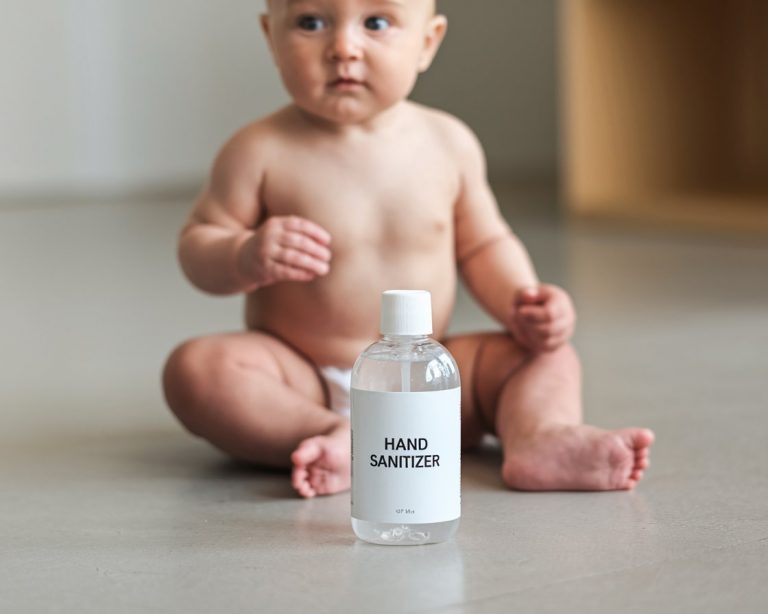Baby’s Soft Spot (Sunken Fontanelles) – Causes, Treatments & Prevention
The human skull is made up of several bones and various tissues. In newborns, the bones are not completely connected at the top, back, and sides of the head, and the fragments are connected by tissues. These spots on the head are called infant soft spots, and they provide flexibility to the baby’s head so that it can pass through the birth canal. These baby’s soft spots get covered up by bones as the baby grows older. Thus it is always said that the baby’s head is delicate and should be handled with utmost care. There are some soft spots on baby’s head that need to be taken care of more than the others for the baby’s health and safety.
What Is a Sunken Fontanelle?
The several soft spots on a baby’s head are known as fontanelles. Two main fontanelles on the skull are those on the back side and on the front side. These soft spots provide flexibility to the skull so that the baby’s head can pass easily through the birth canal. During the baby’s first year of growth, the fontanelles provide space for the brain to grow and develop as required.
These soft spots or fontanelles are generally curved slightly inward. While it is common to see the newborn soft spot slightly curved, a noticeable inward curve can be a matter of serious concern. In medical terms, this is known as a sunken fontanelle in newborns. A very sunken soft spot on the top of the head can be dangerous, and needs immediate medical attention.
Different Types of Fontanelles
Fontanelles are vital for a baby’s development, as they allow the brain to grow and the skull to adapt during childbirth. Understanding the different types of fontanelles can help caregivers recognize normal changes and potential signs of health concerns.:
- Bulging Fontanelle: The soft spot might be bulging a bit outwards, or you might feel a bump at the soft spot. It’s temporary when it disappears after a while, and if the baby cries about it (the head may have been bumped). However, if it does not return to a flat position, it is be a matter of concern.
- Sunken Fontanelle: When the fontanelle is touched, it should be firm, yet with a slight inward curve. When there is a noticeable sink in the head at the soft spot, it can be signs of a sunken soft spot or sunken fontanelle. The sunken fontanelle is related to the health of the child.
- Anterior Fontanelle: The largest soft spot located at the top of the head, which typically closes between 12-18 months of age. It’s the one most often noticed by parents.
- Posterior Fontanelle: This smaller soft spot is located at the back of the head and usually closes by the time the baby is 2-3 months old.
- Sphenoidal Fontanelle: Located on the sides of the baby’s head near the temples, this fontanelle closes relatively early, around 6 months of age.
- Mastoid Fontanelle: Found behind the ears, this fontanelle also closes early in infancy, generally by 6-18 months, and is less commonly discussed compared to the anterior and posterior fontanelle.
Causes of a Sunken Fontanelle on a Baby’s Head
There are many causes of a sunken fontanelle on baby’s head, such as:
1. Dehydration
Dehydration occurs when the body is losing more fluid than it is receiving or retaining. A baby is said to be dehydrated when he does not have sufficient fluid in the body to maintain normal functions. Dehydration can happen due to:
- Frequent urination and not hydrating after
- Vomiting
- Mild to heavy diarrhea
- Excessive sweating
- Not drinking enough fluids
According to the American Family Physician Journal, dehydration in a baby’s body can result in a sunken fontanelle (1).
2. Kwashiorkor Disease
Kwashiorkor a disease that is commonly seen in children, and is the result of a severe deficiency of protein (2). It happens when there is insufficient protein intake through diet. The low amounts of protein can result in a sunken fontanelle.
3. Diabetes Insipidus
Diabetes insipidus is not actually a form of diabetes – it is a rare condition in which the kidneys cannot conserve water. This results in urinating more frequently than normal, and can lead to dehydration and eventually a sunken fontanelle (3).
4. Insufficient Growth
The growth of a child is mainly dependent on nutrition intake. When a child is undernourished due to insufficient intake of calories, or the body’s inability to process the calories, the body fails to thrive (4). When a child’s body cannot meet the normal growth standards, the fontanelle may sink inwards or bulge outwards.
5. Fever
When a baby has a high fever, the body can lose fluids rapidly, leading to dehydration. This fluid loss, if not replaced, may result in a sunken fontanelle.
Risks and Complications of Baby’s Soft Spot
There are several risks and complications related to sunken fontanelles. While some can be minor issues like dehydration, which can be cured by providing fluids and nutrition to the body, there may be other complications that may be fatal, as they can be related to underlying diseases like:
- Brain injury
- Down Syndrome
- Dysmorphic syndromes
How Is a Baby Sunken Fontanelle Diagnosed?
A sunken fontanelle in a baby is diagnosed through a careful physical examination by a healthcare provider, who gently assesses the soft spot on the head for any abnormal sinking. The doctor will also review the baby’s medical history, asking about feeding patterns, fluid intake, urination, and any recent illnesses such as vomiting, diarrhea, or fever (5). Diagnostic tests, such as blood tests to check for dehydration or nutrient deficiencies, may be conducted. Additionally, the doctor will monitor the baby’s growth and development to ensure the baby is meeting normal milestones, as poor growth can contribute to a sunken fontanelle.
What Are the Treatment Options for a Sunken Soft Spot?
If the baby has a sunken fontanelle, the doctor can diagnose it and its cause. Various examinations for assessing the severity of the sunken fontanelle can be done, such as:
- A physical examination by looking, touching, and feeling the soft spots, and assessing the area’s elasticity.
- Examinations through tests like urine tests or blood tests. While the urine tests help in detecting abnormalities such as dehydration, blood tests help in measuring the RBCs and WBCs to detect infections, or disorders like anaemia, which can lead to sunken fontanelles.
- A comprehensive metabolic panel test that helps to detect if the body is suffering from malnutrition.
How to Prevent a Sunken Fontanelle
You can prevent a sunken fontanelle by taking utmost care of the most common cause of it – dehydration. It is essential that your baby’s dietary intake is full of nutrition, and his little body is well-hydrated.
- Be sure to provide fluids to your baby at regular intervals to keep the body hydrated. Increase the amount of fluid given if he is suffering from diarrhoea or vomiting.
- Consult the doctor if you have any doubts about the feeding or if you feel that the baby is in danger of being dehydrated.
- Mothers must eat well and stay hydrated when they are breastfeeding.
- When your child starts eating semi-solids and solids, make sure his diet is nutritious and well-balanced to avoid any kind of growth hindrance or malnutrition.
When Does a Baby’s Soft Spot Go Away?
A baby’s soft spots, or fontanelles, are essential for allowing the skull to grow and accommodate the rapidly developing brain. Over time, these fontanelles gradually close as the bones of the skull fuse together. A baby’s fontanelles typically close in the following sequence:
- Posterior fontanelle: Closes within 1 to 2 months
- Anterior fontanelle: Closes between 13 and 24 months
- Mastoid fontanelle: Closes between 6 and 18 months
- Sphenoid fontanelle: Closes around 6 months after birth
When to Worry About Baby’s Soft Spot
While a slightly sunken soft spot can be normal, it is important to know when to contact the doctor to seek help. If you notice a change in the fontanelles, or you observe that the fontanelles are not flat or have sunken inwards more than usual, you must realize that the soft spot on the baby’s head can prove to be dangerous, and you should contact the doctor immediately. Also, when the baby is not consuming enough fluids or is suffering from diarrhea or vomiting, it is advisable to call the doctor.
Prognosis
While sunken fontanelles are mostly associated with dehydration, sometimes they may occur due to underlying causes other than dehydration. It is essential that, if a child is suffering from dehydration or malnutrition, you immediately seek medical attention. The doctor may provide some immediate fluids to the child in case of dehydration.
A sunken fontanelle is a mild symptom, and can be cured easily at the initial stage. But, neglecting it can result in fatal conditions. Medical attention at the proper time is the best way to keep your child healthy.
FAQs
1. Can teething cause a sunken fontanelle in a baby?
Teething itself does not directly cause a sunken fontanelle. However, if teething leads to reduced fluid intake or increased drooling without adequate hydration, it could potentially contribute to dehydration, which may cause a sunken fontanelle.
2. Can a sunken fontanelle occur due to temperature changes?
Temperature changes alone don’t usually cause a sunken fontanelle, but if the baby becomes overheated and starts sweating excessively without drinking enough fluids, dehydration can set in, leading to a sunken fontanelle.
You do not have to be overly concerned with a soft, slightly sunken fontanelle. The worry can arise when it appears more sunken, or even bulging outwards. Proper care of the soft spot must be observed, as well as ensuring a healthy, well-balanced diet for your child. The latter takes care of fontanelles, as well as overall development! Contact your pediatrician for any non-routine behaviour you observe in your child, such as low consumption of food or fluids, to take more precautions.
References/Resources:
1. Kiesler. J, Ricer. R; The Abnormal Fontanel; American Family Physician Journal; https://www.aafp.org/pubs/afp/issues/2003/0615/p2547.html; June 2003
2. Kwashiorkor; Cleveland Clinic; https://my.clevelandclinic.org/health/diseases/23099-kwashiorkor
3. Diabetes insipidus; Mayo Clinic; https://www.mayoclinic.org/diseases-conditions/diabetes-insipidus/symptoms-causes/syc-20351269
4. Failure to Thrive; Johns Hopkins Medicine; https://www.hopkinsmedicine.org/health/conditions-and-diseases/failure-to-thrive
5. Diagnosing Fluid & Electrolyte Disorders in Children; Hassenfeld Children’s Hospital; https://nyulangone.org/conditions/fluid-electrolyte-disorders-in-children/diagnosis
6. Kamaruzaman. N, Jamani. N, Said. A; An infant with kwashiorkor: The forgotten disease (Malaysian Family Physician); National Library of Medicine; https://www.ncbi.nlm.nih.gov/pmc/articles/PMC7430309/; July 2020
7. Anterior and Posterior Fontanelle Closures; Children’s Hospital Colorado; https://www.childrenscolorado.org/conditions-and-advice/parenting/parenting-articles/fontanelles/
Also Read:
When Can Babies Hold Their Heads Up?
How to Support Baby Brain Development
Infant Head Shape: What’s Normal and What’s Not?
Infant Shaking Head Side to Side: Is it Normal?
Was This Article Helpful?
Parenting is a huge responsibility, for you as a caregiver, but also for us as a parenting content platform. We understand that and take our responsibility of creating credible content seriously. FirstCry Parenting articles are written and published only after extensive research using factually sound references to deliver quality content that is accurate, validated by experts, and completely reliable. To understand how we go about creating content that is credible, read our editorial policy here.






















